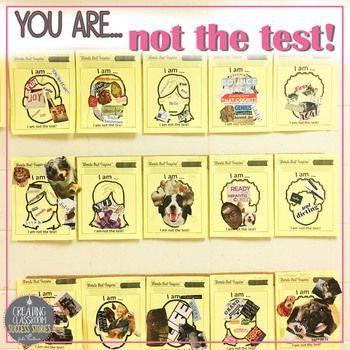Ways People React to Test Anxieties that Might Annoy Others Are You Guilty
Testing season is upon us, and with that comes test anxiety. Although, I’m not sure who has more anxiety about the tests – teachers or students! Either way, the stress that goes along with testing is very real, so I thought a light-hearted post was in order. This post was inspired by a conversation I had with my students after they completed the state writing exam, which is timed and taken on the computers. We aren’t allowed to administer the test to our own students or discuss test content, but I always like to ask them how they feel about it afterward. My honors group had been very nervous, apparently, because their senses were heightened by every possible distraction in the room. To say they were somewhat distracted by every little thing would be a huge understatement. I couldn’t help but laugh as they shared their testing room experience with me. Perhaps their list of “Ways People React to Text Anxieties That Might Annoy Others” will give you a little chuckle.
1. Leg Shaking
Anxiety increases adrenaline levels, and when adrenaline goes up, your body has a natural “fight or flight” response. Leg shaking must equal the need to get up and run out of the room for dear life. It might make time pass more quickly for you, but the person next to you feels as if they are on a bad amusement park ride. If you’re a leg-shaker, try to just wiggle just your toes!
2. Heavy Mouth Breathing and Nose Sniffling
I almost laughed so hard I cried when my kids mentioned this to me, but it’s a reality. When that adrenaline gets going, breathing is a struggle. If you often find yourself short of breath during testing, try to do a few breathing exercises before entering the testing room, so you have that under control!
3. Mumbling
What signifies mumbling, you might ask? Well, if you are Goody Osburn (from The Crucible), mumbling could get you condemned as a witch. If not, you might just be a testing room proctor who isn’t quite on her “A game.” In this case, the proctor was mumbling to herself and hovering during the entire test. When you are reading and writing on the spot, every moment counts. Being distracted by a mumbler, well, that’s not the charm you are looking for.
4. Loud Typing/Writing
Machine guns firing. That’s what my students told me it sounded like when people began typing their essays. (Teenagers love hyperbole.) In a room of complete silence, though, I imagine that is probably true. While some students were still trying to read the text, others were rapidly firing their sentences to beat the clock. Online testing… sounds like an efficient way to collect and grade responses, but in reality, it might not be the best “bang” for the buck.
5. Pen Clicking/Tapping
This is probably my biggest personal pet peeve. It’s not band class and we don’t need a drum roll, but some students/people can’t resist the urge to click, click, click, rap, tap, tapping at my chamber door….. Oh, sorry. I forgot I wasn’t quoting Poe. Yes, the tapping. If pen clicking is your go-to tick during testing, perhaps take some writing utensils that aren’t so interactive or grab a silent Pop-it toy!
Are you guilty of any of these test anxiety quirks? You probably don’t even know you have these aggravating habits, but it is probably driving someone else in the room batty! May the odds be ever in your *testing* favor! Click on the keep calm image below to download a free pdf version of this cute sign!
Click over to my blog post “Best Test Prep Idea and Strategies for Middle and High School Students” for a huge collection of goodies, ideas, and more.
Also, don’t miss my freebie: You Are Not the Test activity, too.
Love this content?
Sign up for my email newsletter with more tips, ideas, success stories, and freebies!















